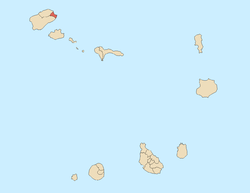Paul, Cape Verde
| Paul | |
|---|---|
| Municipality | |
 | |
| Coordinates: 17°07′N 25°01′W / 17.12°N 25.01°WCoordinates: 17°07′N 25°01′W / 17.12°N 25.01°W | |
| Country | Cape Verde |
| Island | Santo Antão |
| Area | |
| • Total | 54.26 km2 (20.95 sq mi) |
| Population (2010)[1] | |
| • Total | 6,997 |
| • Density | 130/km2 (330/sq mi) |
Paul is a concelho (municipality) of Cape Verde. It covers all the valley named the Vale do Paul. Situated in the northeastern part of the island of Santo Antão, it covers 7% of the island area, and is home to 16% of its population, the majority are rural. Its capital is the town Pombas. In area, the municipality is the 4th smallest and the 19th largest in the nation, in population it had the 17th largest and the 6th smallest in 2000.
Paul are connected with a road linking west Ribeira Grande and north of the island and since 2009 linking east then south and west to Porto Novo and south and west of the island without using the difficult road that crosses high in the mountains at around 1,400 m elevation.
It is part of a protected natural space in Cape Verde under the statute of natural park of Cova-Ribeira da Torre-Paul. The protected area covers Ribeira da Torre, within the Corda Crater and all of Paul Valley with som exception of the southeast.[2]
Its geology consists of basalt rocks formed 1.4 million to 700,000 years ago. It is the known as the Cova Group which has Cova, Corda and Paul rock formations.[3] In the southwest is the Cova crater.
The municipality and parish
The municipality consists of one freguesia (civil parish), Santo António das Pombas. The freguesia is subdivided into the following settlements, it population data was of the 2010 census:
- Cabo da Ribeira (pop: 912)
- Campo de Cão (pop: 787)
- Eito (pop: 979)
- Figueiral (pop: 591)
- Janela (pop: 1,658)
- Pico da Cruz (pop: 138)
- Pombas (town pop: 1,295, total pop: 1,309)
- Passo (pop: 13)
- Ribeira das Pombas (pop: 411)
- Ribeirãozinho (pop: 27)
- Santa Isabel (pop: 186)

Demography
| Population of Paul, Cape Verde (1940—2010) | |||||||
|---|---|---|---|---|---|---|---|
| 1940[4] | 1950[4] | 1960[4] | 1970[4] | 1980[4] | 1990[4] | 2000[5] | 2010[6] |
| 5845 | 5370 | 6024 | 8000 | 7983 | 8121 | 8385 | 6997 |
History
The Municipality of Paul is one of the oldest administrative divisions in Cape Verde. By the end of the 19th century it merged with the older Municipality of Ribeira Grande, becoming the Municipality of Santo Antão. In 1971 the Municipality of Santo Antão was redivided in 3 municipalities: Ribeira Grande, Paul and Porto Novo.
In around 2009 and 2011, several windmills were built in the southeastern part of the municipality in an area where rural roads once difficultly connected to the road to Ribeira Grande and the west of the island, now they are connected with the new road, that area is located between Ponta do Tumbo and the municipal boundary. Windmills provide renewable energy to Paul and the north of the island.
Sport clubs
- Foguetões, the football (soccer) club that currently plays in the north zone of the regional league
- Irmãos Unidos, the football (soccer) club that is a part of the north zone of the regional league
- União Desportivo Janela, the football (soccer) club that currently plays in the north zone of the regional league
- Paulense Desportivo Clube, the chief club of the north zone of the regional league
Notable people
- Antoninho Travadinha, commonly known as Travadinha, one of the most autodidactic musicians of the nation
Politics
From 2004-2008 and since 2012, the Movement for Democracy is the ruling party of the municipality which won 54.7% in the last election.
Municipal assembly
| 2004 % | 2004 seats | 2008 % | 2008 seats | 2012 % | 2012 seats | |
|---|---|---|---|---|---|---|
| Movement for Democracy | 56.44 | 7 | 43.3 | - | 54.7 | 7 |
| PAICV | 43.56 | 6 | 50.3 | - | 42.9 | 6 |
Municipality
| 2004 % | 2004 seats | 2008 % | 2008 seats | 2012 % | 2012 seats | |
|---|---|---|---|---|---|---|
| Movement for Democracy | 56.12 | 5 | 44.2 | 0 | 55.4 | 7 |
| PAICV | 43.88 | 0 | 51.4 | 7 | 42.3 | 0 |
Sister cities
Paul has three sister cities and municipalities, all of them are in Portugal: Almodôvar, Benavente and Sernancelhe
References
- ↑ "2010 Census results". Instituto Nacional de Estatística Cabo Verde (in Portuguese). 17 March 2014.
- ↑ Áreas protegidas, Cabo Verde (Portuguese)
- ↑ Holm, Paul Martin (2006). Sampling the Cape Verde Mantle Plume: Evolution of Melt Compositions on Santo Antão, Cape Verde Island. 47. p. 145-18. doi:10.1093/petrology/egi071.
- 1 2 3 4 5 6 Source: Statoids
- ↑ Source: Instituto Nacional de Estatísticas.
- ↑ "2010 Census results Santo Antão". Instituto Nacional de Estatística Cabo Verde (in Portuguese). 23 March 2014.
External links
| Wikimedia Commons has media related to Paul, Cape Verde. |
- ANMCV (Associação Nacional dos Municípios Cabo-Verdianos - National Association of the Capeverdean Municipalities)
- Official Paul Tourism Website by Municipal Council of Paul